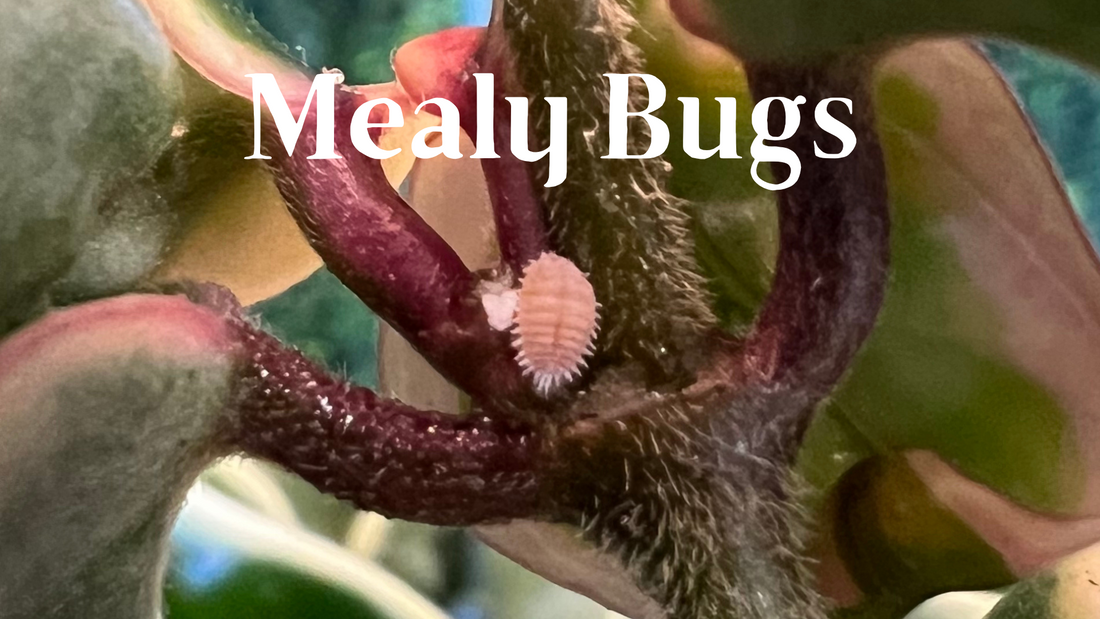
Houseplants are an incredible addition to any indoor space, bringing life, color, and a touch of nature to our homes. However, despite our best efforts, they can sometimes fall victim to unwanted invaders, such as mealy bugs. Mealy bugs are small, soft-bodied insects that feed on plant sap, leaving behind a trail of damage if left untreated. In this blog post, we will explore what mealy bugs are, how they infest plants, which plants are most prone to them, and most importantly, how to identify, prevent, and treat them.
- What are Mealy Bugs?
Mealy bugs (Pseudococcidae) are tiny, wingless insects that belong to the scale insect family. They are typically found in clusters and are covered in a waxy, white, cotton-like substance that acts as a protective layer. The wax serves as camouflage and shields the bugs from predators, making them challenging to spot. These pests are notorious for being sap-suckers, which means they pierce plant tissue and feed on the plant's sugary fluids, leading to weakened growth and potential death if left unchecked.

A young mealybug
- How do Plants get Infested by Mealy Bugs?
Mealy bugs can find their way into our homes through various means. They may hitch a ride on new plants that we bring home, either as adults, eggs, or nymphs. Alternatively, they can be transmitted through contaminated gardening tools or by pests that have already infested other houseplants nearby. They are especially attracted to plants with tender, succulent growth, and once they find a suitable host, they reproduce rapidly, making it crucial to address infestations early on.
- Plants Most Prone to Mealy Bug Infestations
While mealy bugs are opportunistic pests that can attack a wide range of houseplants, some species are more susceptible than others. Plants with soft, fleshy foliage, or those that produce a significant amount of new growth, are particularly attractive to these pests. Common plants prone to mealy bug infestations include:
a) African violets
b) Orchids
c) Ficus trees]
d) Pothos
e) Spider plants
f) Hoyas
g) Ferns
- Identifying and Treating Mealy Bug Infestations:
Identifying mealy bugs can be tricky due to their small size and wax-like covering, but attentive observation is key. Look out for the following signs of infestation:
- White, cottony masses on stems, leaves, or in leaf axils.
- Yellowing or wilting leaves.
- Sticky honeydew secretions that attract ants or mold growth.
- Distorted or stunted growth.

White, sticky glob of mealy bugs on a ficus tree
Once you've confirmed a mealy bug infestation, prompt action is crucial to prevent further damage. Here's how to treat them effectively:
a) Isolate the Infested Plant: Immediately move the infested plant away from other houseplants to prevent the pests from spreading.
b) Manual Removal: Use a cotton swab dipped in rubbing alcohol to carefully remove the bugs from the plant's nooks and crannies. Alternatively, you can use a strong stream of water to dislodge them from the foliage.
c) Neem Oil Solution: Neem oil acts as a natural insecticide and can disrupt the mealy bugs' life cycle. Our Neem & Gleam spray should be a part of your routine plant care and treatment!
d) Insecticidal Soap: Insecticidal soaps can be effective against mealy bugs. Neem and Gleam also contains organic insecticidal soap to treat pests.
e) Biological Controls: Some beneficial insects, like ladybugs and lacewings, are natural predators of mealy bugs. Introducing these insects into your plants can help control the infestation.

Rubbing alcohol can be dabbed directly onto the bug to eliminate it
Conclusion
Mealy bugs can quickly become a nuisance, but with vigilance and proper treatment, their impact can be minimized. Regularly inspect your houseplants for signs of infestations and take immediate action if you spot them. Remember to isolate affected plants, manually remove the bugs, and use natural or chemical remedies to treat the infestation. By being proactive and attentive, you can ensure that your houseplants thrive and remain pest-free, bringing beauty and tranquility to your home for years to come.

